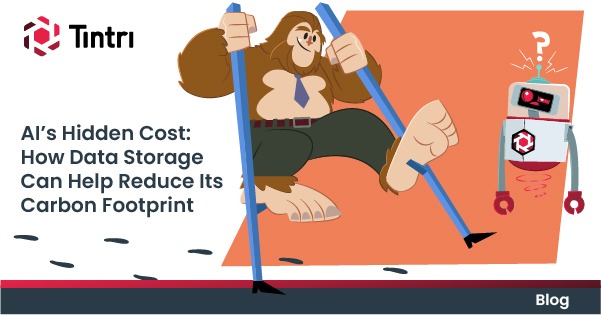Virtual machines (VMs) have transformed the way businesses manage their IT infrastructure. With virtualization, companies can run multiple virtual machines on a single physical server, which has dramatically improved server utilization and reduced costs associated with hardware and energy consumption. However, with the increased number of virtual machines, IT complexity has also grown, and storage has become a major bottleneck. Traditional storage systems were not designed to work with virtualized environments, leading to inefficiencies and high costs. Enter data management solutions like VM-aware storage – which simplifies IT complexity and reduces costs versus the traditional tech stack.
What is VM-Aware Storage?
VM-aware storage is a data management solution designed specifically for virtualized environments. It understands the needs of virtual machines and can optimize storage performance accordingly. Traditional storage systems were designed for physical servers, and they treat virtual machines as just another application running on the server. VM-aware storage, on the other hand, treats each virtual machine as a unique entity with specific requirements. It can automatically allocate storage resources to virtual machines based on their performance and capacity needs, ensuring that the data management system is optimized for the virtual environment. This is all achieved with absolutely zero manual intervention by the IT team.
Simplifying IT Complexity
One of the biggest challenges in managing a virtualized environment is the complexity of the IT infrastructure. With multiple virtual machines running on a single server, it can be difficult to manage resources efficiently. Traditional storage systems require manual intervention to allocate those resources, which can be time-consuming and error prone. VM-aware storage, however, can automatically manage storage resources, ensuring that each virtual machine has exactly what it needs to perform optimally. This simplifies storage management and reduces the workload on IT staff.
Stacking Up Against the Traditional Tech Stack
Much as we wish otherwise, VM-aware storage cannot replace the traditional tech stack in its entirety, but it can significantly simplify storage management and improve performance in environments that use Cloud Storage, Disaster Recovery, Ransomware Protection, DevOps, multiple hypervisors, SQL, VDI, and Analytics. Let’s look at how VM-aware storage can help:
- Cloud Storage: VM-aware storage can be integrated with cloud storage solutions to simplify storage management tasks, such as creating and deleting virtual machines, allocating storage resources, and optimizing storage performance. By automating these tasks, VM-aware storage can reduce the workload on IT staff and enable faster deployment of applications in the cloud. Moreover, VM-aware storage can replicate data to multiple cloud storage locations, ensuring that data is always available and protected against data loss.
- Disaster Recovery: VM-aware storage can be used in conjunction with disaster recovery solutions to ensure that virtual machines can be quickly recovered in the event of a disaster. By replicating virtual machine data to secondary storage systems, VM-aware storage can ensure that critical data is protected and can be recovered quickly, minimizing downtime.
- Ransomware Protection: VM-aware storage can protect against ransomware by automatically creating and maintaining secure backups of virtual machines, even those that are offline. By creating Immutable Snapshots and maintaining them in an isolated location, VM-aware storage can provide quick and easy access to unaffected data sets, reducing recovery times and minimizing data loss.
- DevOps: VM-aware storage can be integrated with DevOps tools to automate storage management tasks, such as creating and deleting virtual machines, allocating storage resources, and optimizing storage performance. By automating these tasks, VM-aware storage can reduce the workload on IT staff and enable faster deployment of revenue generating applications.
- Multiple Hypervisors: VM-aware storage is compatible with multiple hypervisors, including VMware, Hyper-V, and KVM. This enables companies to choose the hypervisor that best meets their needs without being locked into a specific storage solution.
- SQL: VM-aware storage can improve SQL performance by automatically optimizing storage resources for SQL workloads. By allocating storage resources based on the specific needs of SQL workloads, VM-aware storage can improve performance and reduce the risk of data loss.
- VDI: VM-aware storage can improve VDI performance by optimizing storage resources for virtual desktop workloads. By allocating storage resources based on the specific needs of VDI workloads, VM-aware storage can improve performance and reduce the risk of downtime.
- Analytics: Although there are many claims of VM-level analytics, the litmus test for true VM-aware analytics is that it allows you to dig into the Real Time performance characteristics of individual VMs with precision, NOT estimations or correlations. In just seconds, it is possible to identify the source of latency, whether it is at the disk, server or network level. Taking it to the next level, Tintri delivers powerful VM-aware cloud-based Predictive Analytics for resource planning by IT departments. For example, predicting what the server and storage impact will be when changes are made, such as doubling the number of instances of an application, changes in data growth or implementing a new application.
Reducing Costs
Cost reduction is one of the primary benefits of VM-aware storage. Traditional storage systems are expensive, and they require significant capital investment. They also consume a lot of energy, which can add up to significant costs over time. VM-aware storage, on the other hand, is designed to work with virtualized environments, which means it requires fewer resources to operate. This reduces energy consumption and lowers costs associated with hardware and software licensing. In addition, VM-aware storage can improve storage utilization rates, which means companies can do more with less storage. This reduces the need to invest in additional storage resources, further lowering costs.
Solutions such as the Tintri VMstore go one step further with a single appliance for data management and allow orchestration from one hypervisor, thus further reducing footprint, costs, and complexity.
Conclusion
As a matter of fact, Tintri recognized the pain points faced by organisations and launched its first VM-aware data management systems more than 12 years ago. VM-aware data management appliances such as the Tintri VMstore are a game-changer for virtualized environments. They simplify IT complexity and reduce costs associated with traditional storage solutions. By understanding the needs of virtual machines and optimizing storage performance accordingly, VM-aware storage ensures that the system is optimized for the virtual environment. This simplifies storage management, reduces the workload on IT staff, and lowers costs associated with hardware and energy consumption. As more companies adopt virtualization, VM-aware storage will become an essential tool for managing the IT infrastructure.
#Tintri #VMaware #storage #datamanagement #techstack





